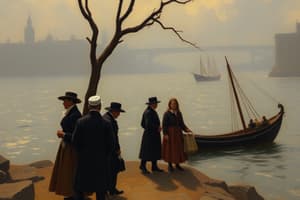Podcast
Questions and Answers
What were Old Immigrants primarily known for?
What were Old Immigrants primarily known for?
- Working only in agriculture
- Coming from western and northern Europe (correct)
- Representing modern immigrants
- Coming from southern Europe
What areas did New Immigrants come from?
What areas did New Immigrants come from?
Southern and eastern Europe, and Asia.
What is Steerage?
What is Steerage?
The part of a ship providing accommodations for passengers with the cheapest tickets.
What are Tenements?
What are Tenements?
What was the purpose of the Benevolent Society?
What was the purpose of the Benevolent Society?
What did the Chinese Exclusion Act prohibit?
What did the Chinese Exclusion Act prohibit?
When was the Immigration Restriction League founded?
When was the Immigration Restriction League founded?
What is Mass Transit?
What is Mass Transit?
What are Suburbs?
What are Suburbs?
What was Hull House?
What was Hull House?
What is a Settlement House?
What is a Settlement House?
What does Mass Culture refer to?
What does Mass Culture refer to?
What was Ellis Island known for?
What was Ellis Island known for?
What was Angel Island?
What was Angel Island?
Who was Jane Addams?
Who was Jane Addams?
What are Sweatshops?
What are Sweatshops?
Flashcards are hidden until you start studying
Study Notes
Immigration Concepts
- Old Immigrants: Settlers from western and northern Europe, mainly England, arriving during the colonial period for social, political, and economic reasons.
- New Immigrants: Immigrants from southern and eastern Europe (e.g., Italy, Russia, Poland, Greece) and Asia (e.g., China, Japan), representing a shift in immigration patterns.
Maritime Travel
- Steerage: Lowest-cost accommodations on ships used by many immigrants traveling to America, often involving harsh conditions.
Urban Living Conditions
- Tenements: Poorly constructed residences in urban areas, typically overcrowded and unsanitary, contributing to high disease rates.
Benevolent Societies
- Benevolent Society: Founded in 1813 by Edward Smith Hall in Australia, it served as the first independent charity aiding individuals to overcome societal participation barriers.
Immigration Legislation
- Chinese Exclusion Act: Federal law enacted on May 6, 1882, by President Chester A. Arthur, prohibiting Chinese laborer immigration, marking a significant restriction in U.S. immigration policy.
- Immigration Restriction League: Established in 1894 by Harvard graduates advocating for literacy requirements to limit immigration into the U.S.
Transportation Development
- Mass Transit: Evolved from the early 19th century, including steam ferries and horse-drawn omnibuses, significantly impacting urban development until the rise of automobile ownership in the 1920s. Current trends prioritize sustainability and revitalization.
Urban Geography
- Suburbs: Residential areas located on the outskirts of cities, reflecting urban expansion and population shifts.
Settlement Houses
- Hull House: Co-founded in 1889 by Jane Addams and Ellen Gates Starr in Chicago, it offered support and services to European immigrants.
- Settlement House: Institutions that provide various social services, education, and recreation in inner-city communities.
Cultural Developments
- Mass Culture: Represents a shared set of ideas and values arising from common exposure to media, rather than local interactions, shaping public consciousness.
Immigration Stations
- Ellis Island: Served as the busiest U.S. immigrant inspection station from 1892 to 1954, processing over 12 million immigrants.
- Angel Island: Operated from 1910 to 1940 as an immigration station in San Francisco Bay, where many Asian immigrants faced extensive detention and interrogation.
Influential Figures
- Jane Addams: A key figure in social reform and women's suffrage, remembered for establishing Hull House and championing social justice.
Labor Conditions
- Sweatshops: Factories characterized by poor working conditions and exploitation, prevalent during periods of high immigration and labor demand.
Studying That Suits You
Use AI to generate personalized quizzes and flashcards to suit your learning preferences.





